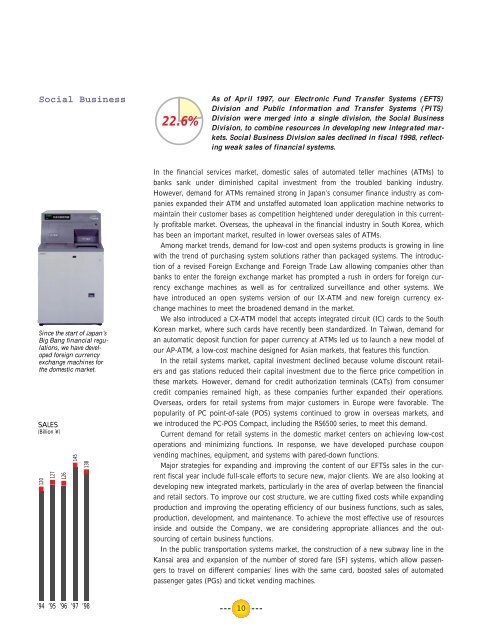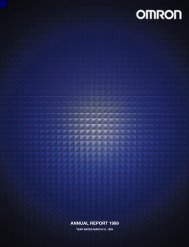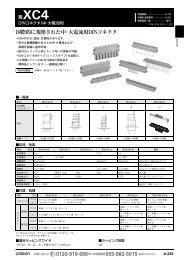Annual Report 1998 - Omron
Annual Report 1998 - Omron
Annual Report 1998 - Omron
You also want an ePaper? Increase the reach of your titles
YUMPU automatically turns print PDFs into web optimized ePapers that Google loves.
Social Business<br />
22.6%<br />
As of April 1997, our Electronic Fund Transfer Systems (EFTS)<br />
Division and Public Information and Transfer Systems (PITS)<br />
Division were merged into a single division, the Social Business<br />
Division, to combine resources in developing new integrated markets.<br />
Social Business Division sales declined in fiscal <strong>1998</strong>, reflecting<br />
weak sales of financial systems.<br />
Since the start of Japan’s<br />
Big Bang financial regulations,<br />
we have developed<br />
foreign currency<br />
exchange machines for<br />
the domestic market.<br />
SALES<br />
(Billion ¥)<br />
120<br />
127<br />
126<br />
145<br />
138<br />
In the financial services market, domestic sales of automated teller machines (ATMs) to<br />
banks sank under diminished capital investment from the troubled banking industry.<br />
However, demand for ATMs remained strong in Japan’s consumer finance industry as companies<br />
expanded their ATM and unstaffed automated loan application machine networks to<br />
maintain their customer bases as competition heightened under deregulation in this currently<br />
profitable market. Overseas, the upheaval in the financial industry in South Korea, which<br />
has been an important market, resulted in lower overseas sales of ATMs.<br />
Among market trends, demand for low-cost and open systems products is growing in line<br />
with the trend of purchasing system solutions rather than packaged systems. The introduction<br />
of a revised Foreign Exchange and Foreign Trade Law allowing companies other than<br />
banks to enter the foreign exchange market has prompted a rush in orders for foreign currency<br />
exchange machines as well as for centralized surveillance and other systems. We<br />
have introduced an open systems version of our IX-ATM and new foreign currency exchange<br />
machines to meet the broadened demand in the market.<br />
We also introduced a CX-ATM model that accepts integrated circuit (IC) cards to the South<br />
Korean market, where such cards have recently been standardized. In Taiwan, demand for<br />
an automatic deposit function for paper currency at ATMs led us to launch a new model of<br />
our AP-ATM, a low-cost machine designed for Asian markets, that features this function.<br />
In the retail systems market, capital investment declined because volume discount retailers<br />
and gas stations reduced their capital investment due to the fierce price competition in<br />
these markets. However, demand for credit authorization terminals (CATs) from consumer<br />
credit companies remained high, as these companies further expanded their operations.<br />
Overseas, orders for retail systems from major customers in Europe were favorable. The<br />
popularity of PC point-of-sale (POS) systems continued to grow in overseas markets, and<br />
we introduced the PC-POS Compact, including the RS6500 series, to meet this demand.<br />
Current demand for retail systems in the domestic market centers on achieving low-cost<br />
operations and minimizing functions. In response, we have developed purchase coupon<br />
vending machines, equipment, and systems with pared-down functions.<br />
Major strategies for expanding and improving the content of our EFTSs sales in the current<br />
fiscal year include full-scale efforts to secure new, major clients. We are also looking at<br />
developing new integrated markets, particularly in the area of overlap between the financial<br />
and retail sectors. To improve our cost structure, we are cutting fixed costs while expanding<br />
production and improving the operating efficiency of our business functions, such as sales,<br />
production, development, and maintenance. To achieve the most effective use of resources<br />
inside and outside the Company, we are considering appropriate alliances and the outsourcing<br />
of certain business functions.<br />
In the public transportation systems market, the construction of a new subway line in the<br />
Kansai area and expansion of the number of stored fare (SF) systems, which allow passengers<br />
to travel on different companies’ lines with the same card, boosted sales of automated<br />
passenger gates (PGs) and ticket vending machines.<br />
’94 ’95 ’96 ’97 ’98<br />
10




